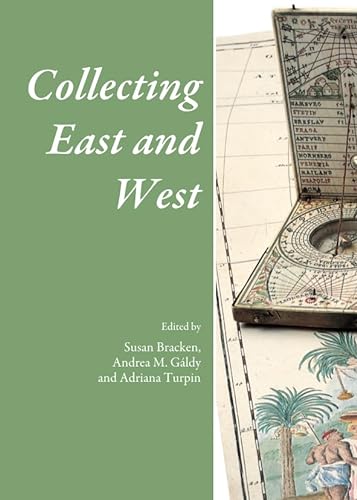Collecting East and West (Collecting Histories) - Hardcover

Zu dieser ISBN ist aktuell kein Angebot verfügbar.
Alle Exemplare der Ausgabe mit dieser ISBN anzeigen:
Críticas:
''This beautifully illustrated volume presents a series of seven case studies that examine how individuals and institutions have collected and displayed exotica from Europe, Asia, and the New World. Ranging from Neo-Assyrian Mesopotamia to twentieth-century London, the essays show how these collections reflected and shaped notions of east and west, and uncover the intellectual and aesthetic choices that lay behind them. All the chapters are intelligent, persuasive, and rich in documentation; collectively, they demonstrate the continuing appeal of new and foreign objects, and the political implications of their display. The book will be of great value for anyone interested in the origins and evolution of the cabinet of wonders, and makes an important contribution to the history of collecting in Europe.'' - William Stenhouse, Associate Professor of History, Chair Department of History, Yeshiva University, New York''This new volume - East and West - in the Collecting and Display series brings together a group of essays dedicated to cultural transfers between Europe, Asia and the Americas. Presented here are case studies which span different periods of time and continents. An excellent introduction by Arthur MacGregor focuses on maritime routes as a means of artistic exchange between Asia, Africa, Europe and the New World, underscoring how merchants, commerce and trade in the Age of Discovery stimulated not only communication, but also cultural transfers, diplomatic exchanges and artistic production on all levels. Eight chapters focus on specific aspects of commercial, artistic and cultural transfers between East and West, complimented by an index and excellent images. Commerce and trade had an impact on collecting and menageries in first millennium Assyria (Karmel Thomason), no less than it did on Medicean Florence in the Renaissance (Turpin). Skogh examines how exotic fruit affected the Swedish court in the seventeenth century. While, Greek marbles belonging to Comte de Choiseul-Gouffier (Michel) are shown to have been no less significant than the Elgin marbles removed from the Parthenon. Gallori demonstrates how Hernan Cortes booty from Mexico fascinated the Habsburg court in 1519, while China and Japan remained no less of a fascination for eighteenth and turn of the century collectors (Davoli, Bienaime & Ying-Ling Huang). This volume undertakes to map out collectors-East and West-and their criteria for collecting, underscoring how commerce and art intersected in time and social levels.'' - Annemarie Jordan Gschwend, author of A rainha colecionadora. Catarina de Austria (2012), The Story of Suleyman and other Exotica in Renaissance Portugal (2010) and guest curator of Elfenbeine aus Ceylon. Luxusguter fur Katharina von Habsburg (1507-1578) (2010).
Reseña del editor:
If collecting the rare and valuable is an entirely normal trait of human behaviour, amassing objects from far-away places has also long played a role in the history of collecting. "East" and "West", or "North" and "South", for that matter, are of course entirely relative to one's particular geographical position. Therefore, it is interesting that collecting exotic objects is an endeavour that unites humanity over millennia and round the globe. The ancient Assyrians did so as assiduously as eighteenth-century collectors in Paris or London; Chinese emperors collected Western art and artefacts at a time when Western collectors started to gather ceramics, lacquered furniture, or South-East Asian prints. Key factors were, of course, increasingly frequent contact and an ever growing knowledge about the "other" and about the other's artistic production.Of particular interest to the mission of this working group is the fact that the building of collections was only part of the endeavour but that, in many cases, the objects imported at huge cost and logistic effort were meant to be displayed in surroundings reminiscent of their original habitat, even though their exact original context may have been open to debate and their final exhibition surroundings may have been unrecognisable to anyone from their former home. Western collectors built Chinese cabinets for their exotic treasures, often complemented by depictions of Oriental tea parties. Less familiar is perhaps the fact that, from the seventeenth century onwards, Chinese emperors displayed their European collectibles in palaces built for them for this purpose in Western architectural style.The essays in the present volume, therefore, attempt to connect the collections of exotic objects with the forms of display adopted by collectors and institutions and thus chart the levels of increasingly informed and intimate encounters between East and West, scholars and collectors, art lovers and institutions from the early first millennium BC to the early twentieth century and from South-East Asia to North-Western Europe.
„Über diesen Titel“ kann sich auf eine andere Ausgabe dieses Titels beziehen.
- VerlagCambridge Scholars Publishing
- Erscheinungsdatum2013
- ISBN 10 1443847798
- ISBN 13 9781443847797
- EinbandTapa dura
- Anzahl der Seiten250
- HerausgeberGáldy Andrea M., Turpin Adriana
(Keine Angebote verfügbar)
Buch Finden: Kaufgesuch aufgebenSie kennen Autor und Titel des Buches und finden es trotzdem nicht auf ZVAB? Dann geben Sie einen Suchauftrag auf und wir informieren Sie automatisch, sobald das Buch verfügbar ist!
Kaufgesuch aufgeben